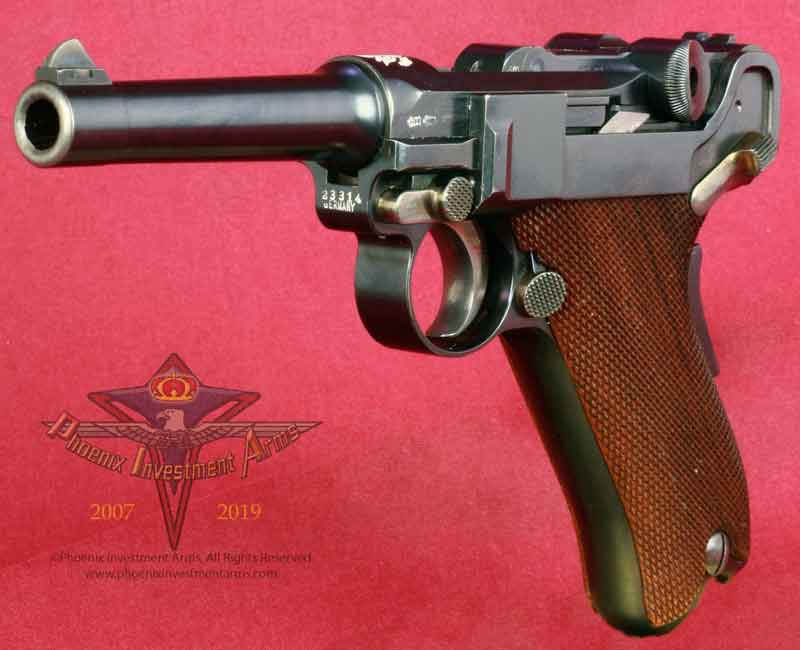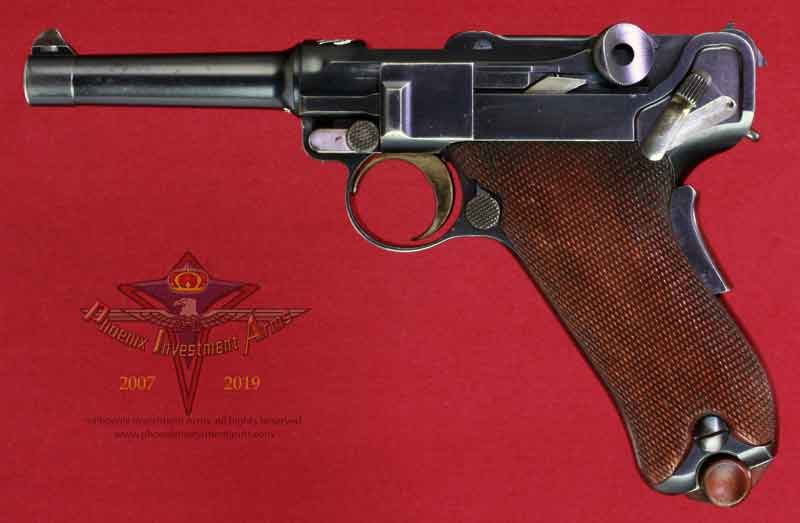1902 American Eagle "Fat Barrel"
PHOENIX INVESTMENT ARMS - PREMIUM COLLECTOR LUGERS
Genuine German Luger - Largest Variety of Lugers Offered
Home | Post WWI DWM | Erfurt Lugers | Mauser | Simson Suhl | Krieghoff | Vickers, Ltd | Swiss Bern | Other Guns
Bottom of Page
|
In September 1902 DWM (Deutsche Waffen und Munitionsfabriken)
began to manufacture the 9mm which was developed by Georg Luger after the
military test trials in the United States. These
had the 4" (100mm) barrel that was a "thick" or "fat barrel" as they
are known by collectors. Production continued into 1903 for the
"fat barrel" series to include the American Eagle Fat Barrel, The American
Eagle Cartridge Counter and the Commercial Fat Barrel. (2131) |
|
|
|
NOTE: Photographs taken today with the high mega-pixel camera show more than we sometimes can see with the human eye. Magnified close-ups show us tool marks and natural surface conditions that one normally doesn't see in the ordinary handling of the weapon. Photographs are copyrighted, all rights reserved, any extraction, reproduction or display of gun pictures without the express consent of the Phoenix Investment Arms is strictly prohibited. Thank you for your cooperation. Please visit Legal (tabbed) for Conditions of Sale. |
|
To understand the early Parabellum production you must understand the serial number system and how it was applied. In 1900 at the start of commercial production (although George Luger made Lugers in 1897, 98 and 99 it was in 1900 that the full production of the 1900 Model was underway). There were two assembly plants established to manufacture the gun, one use the Crown U, Crown B proofs the second made guns without these proofs. Therefore DWM was exercising strict quality control of the pieces. The serial number range for the 1900 Luger was from 1 to 9999. The serial number range from 1901 produced Lugers was 1 to 9999. To differentiate you must go to the design of the thumb safety. The 1890's - 1900 models used the Type I safety which was long flat and cross checkered. Somewhere around 400 serial number in 1901 they began to use the Type II safety which was high domed and cross checkered. These Type II also seem to show up on presentation and "B" Model Prototypes. |
|
|
|
This early 9mm model with the 100mm barrel that measures 16.6mm
at the throat and tapers to 15mm at the sight band. Giving the gun
the "fat barrel" look. The name was assigned by collectors to set apart these first 9mm pistols. Compare this to
the standard 9mm which measured 15.5 mm at the throat and tapers to 13.7
at the sight band. |
|
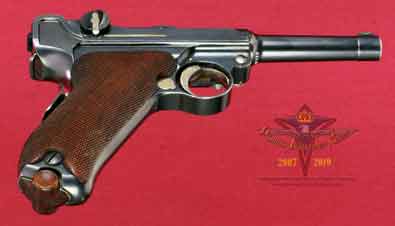
|
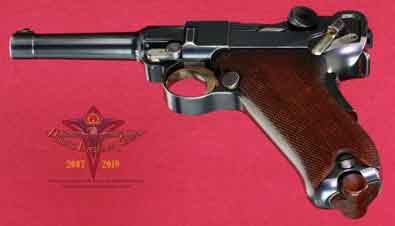
|
| This early Parabellum has all the characteristics of the very early Lugers: flat breech block and old model receiver with the self-retaining extractor up to the classically dished toggles. Also note the early wide trigger guard 14.8mm (.585") and the narrow early trigger .330". | |

|
|
Bottom view showing
the five digit serial number, the two digits on the bottom of the
side plate, and locking lever. the wide trigger guard and the Cal 9mm marking on the
magazine to alert the owner that this was not the 7.65mm that was
prevalent at that time. |
|
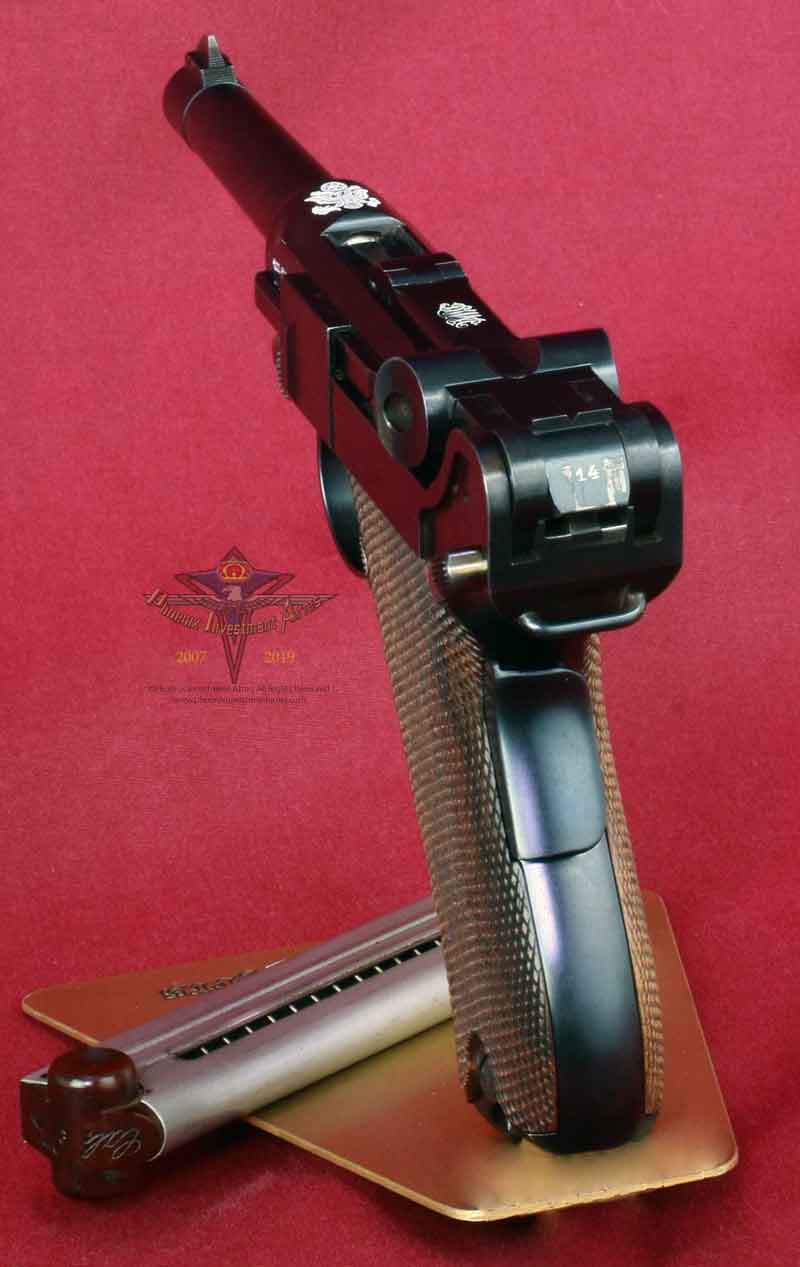 |
|
All the small parts have been serial
numbered. This model has the wide grip safety and three digits on
the rear toggle the underside of the side plate and the squeeze grip
lever. This is a very early "Fat Barrel" and as such shows these
early serial number markings. |
|
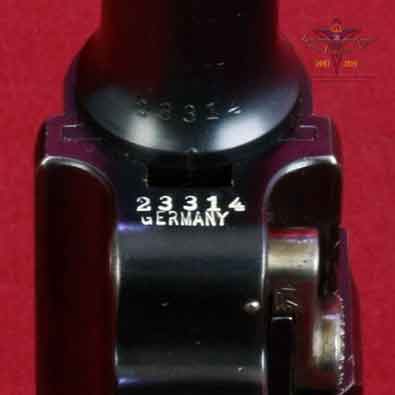
|
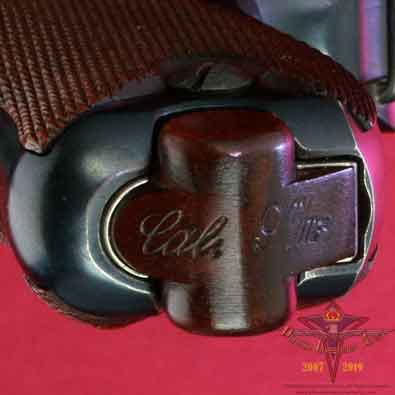
|
The
origination of the five digit serial numbers for the commercial
Parabellum is shown above on the matching barrel and receiver.
The magazine is the original deeply stamped Cal 9mm indicating
that this was a change of ammunition for those who were already
familiar with the Luger and the up to then standard use of the
7.65mm .30 Caliber Luger guns. Many people today are confused
switching between the mm and caliber designations. |
|
The decision was made to begin
the serial number range for the 7.65mm, 4 3/3" barrel (120mm) 1902 Luger
with 10001-21999 and these ran until September 1902. In August 1902 DWM
began making carbines in the 21000 range, these are the very early
carbines. In September 1902 DWM began to manufacture the 9mm Luger
within the 22000-22999 and included in this group are the 02 American
Eagle, the 02 Commercial, the late 9mm commercial carbine, the 1902
American Eagle Cartridge Counter 22401-22450 and the 1902 Danzig Luger.
With the completion of the Cartridge Counter there were the "fat barrels"
still on the shelf so DWM continued to assemble the 9mm American Eagle and
Commercial Fat Barrel until they ran out. This pushed this model into 1903
when the serial numbers changed to 23000-23999.TEXT
|
 |
|
Very rarely do these "Fat Barrels become available and mostly they start at $15,000 or better, however this once-in-lifetime this Parabellum comes out of a collection bargain priced to settle an estate and is a super deal. We are extending out layaway to fifteen months with 20% down. |
|
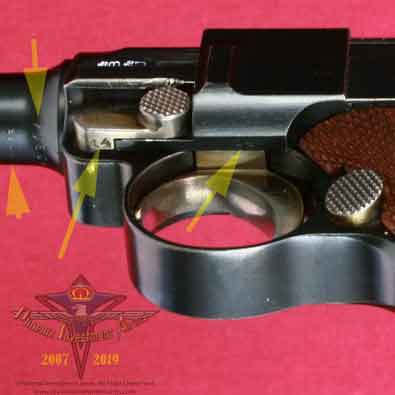
|
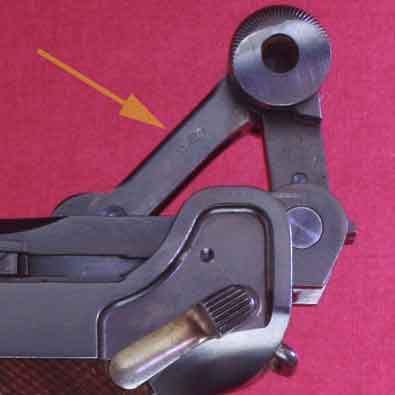 |
Above Left: The small parts bear the last two digits of the serial number and are "hidden" in the commercial manner. On the receiver and the 1st toggle link (Above Right) are the Crown B.U. Proofs. Collectors prize
the guns that are BU proofed. The Crown B (Beschuss) means the barrels were
tested using a heavier load in accordance with the 1892 proof law. The
Crown U (Untersuchung) means it was inspected after assembly. |
|
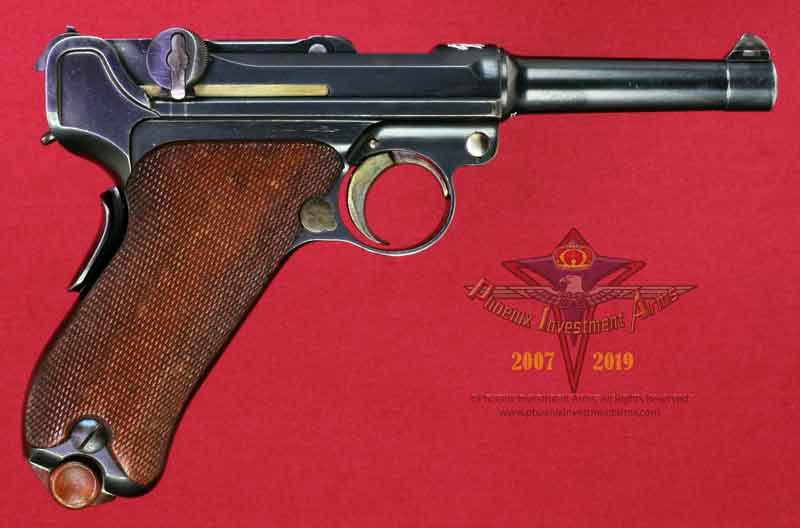 |
|
One is first impressed with the thick 9mm
barrel, 4" (100mm) in length. There are very few of the 'fat' barrels
in existence and this one is recognized with the 23314 serial number
placing it's production in 1903. |
|
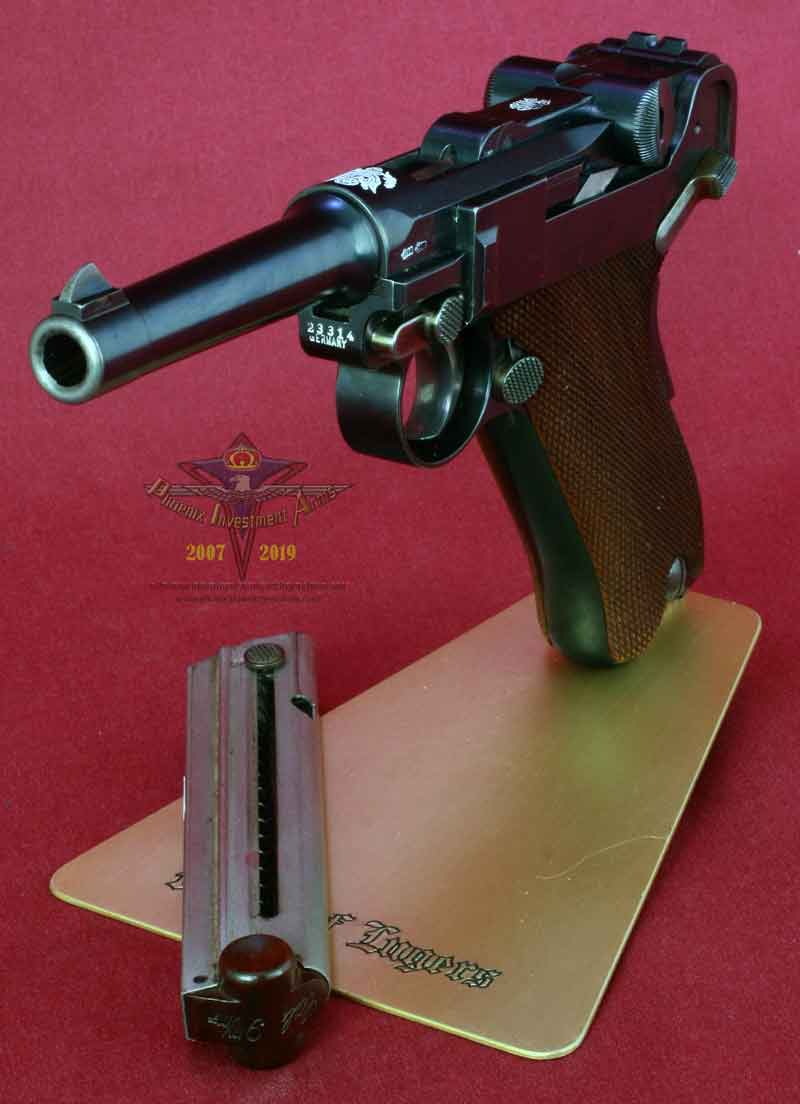 |
|
It is entirely subjective to give any firearm a rating of excellent or fine, just as it is to declare it xx% blued or strawed. Few collectible weapons are out of the box new and these are premium priced. Bluing percentages is like Beauty, in the eye of the beholder. We strive to provide pictures
so you can judge for yourself if the gun meets your criteria. Any questions or request for additional purchases email to josef@phoenixinvestmentarms.com. This firearm is eligible for transfer to C&R permit holder, even in California. We are registered with CA DOJ for firearms shipment. |
|
In 1902 some
models showed the three digit serial numbers on the small parts.
By 1903 this practice was discontinued and there were no 120mm 7.65mm
Parabellums produced in 1903. Also of note is the wide squeeze grip safety
which was eventually phased out.
|
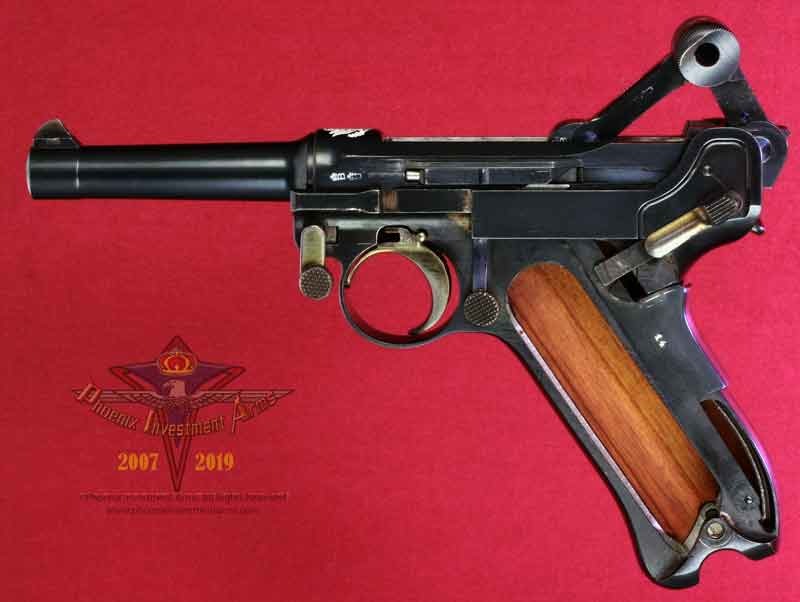
|
|
|
The inside of the gun is as clean
and well maintained as the exterior. you can see all the matching
serial numbers on all the small parts and the long sear and the long frame of the prior 1908 models, the thumb safety down (Safe) when the "in the white" metal is exposed.
| |
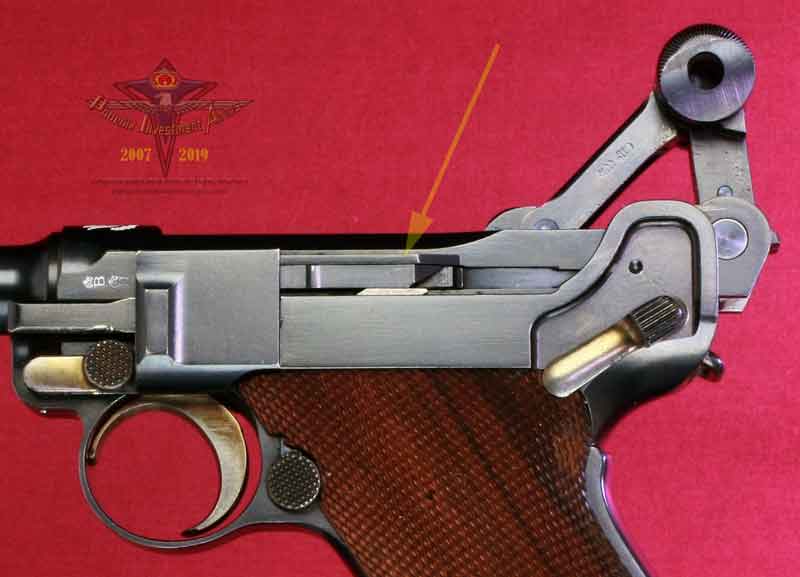 |
|
|
Here is a good illustration of the long sear (by arrow) which would only function when the thumb safety was off and the squeeze grip safety was depressed. The prevented the gun being toggled or cocked when the safety was on, nor could it be unloaded. This was recognized early on by Georg Luger who redesigned the short sear that enabled both to occur. |
|
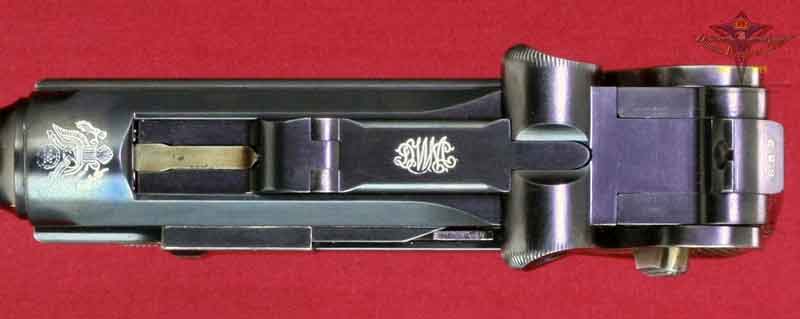 |
|
|
Serial number placement is in the
commercial "hidden" style; displayed on the bottom the side plate, the and locking bolt, the front of the frame, under the
barrel, and on the side of the trigger. This example has
all matching numbers. There are no usual proof marks, except for the
export "Germany" found on other
guns of this period and represents a very clean pristine look to enhance
the beauty of the gun. |
|

|
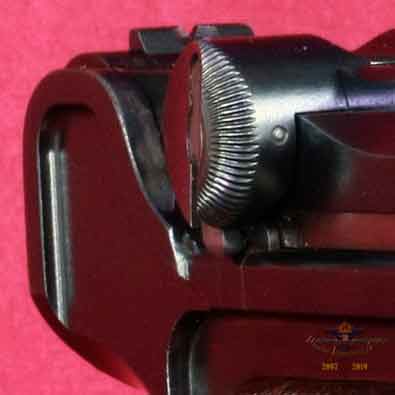
|
|
The toggles are the old style "dished" with the serrations cut around the front. The toggle link was held in place by the pin on the front of the toggle, with the other variation being designed with the top of the pin fitted into the toggle. When the recoil moved the toggle backwards it struck the rear rails which raised it up and the "knee action" began to extract the shell. |
|
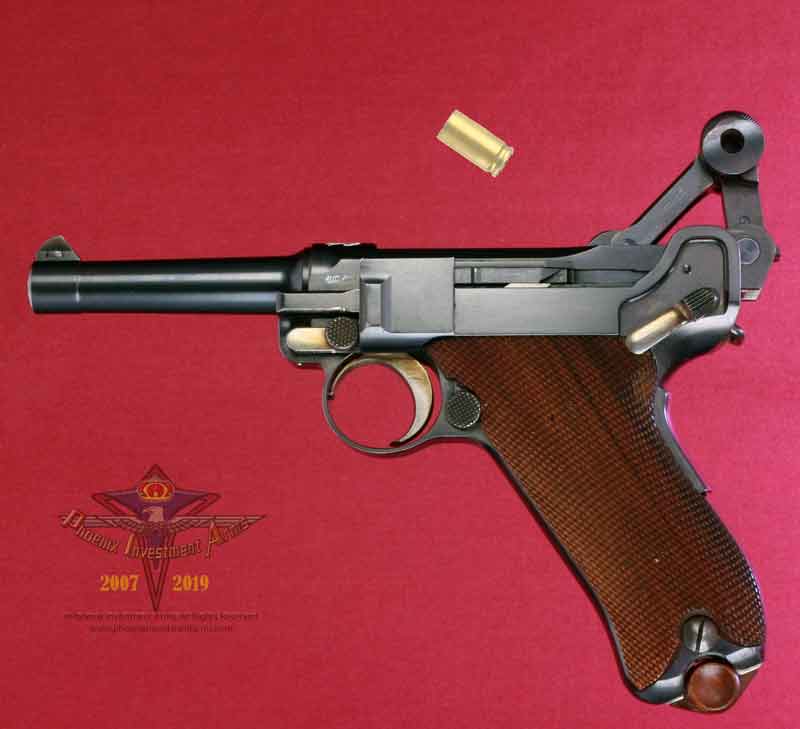
|
|
The most distinctive feature of these
pistols is undoubtedly the toggle-lock mechanism, which holds the breech
closed by locking in a manner not unlike the human knee, which can
sustain a heavy weight when straight, but once bent is quite easy to
continue to bend. The toggle joint in its straight position resists the
rearward force of the detonating cartridge, then "buckles" after enough
time has passed. When a round is fired the entire breech, barrel and toggle move straight
rearward (on rails) until the toggle begins to ride up on a pair of cams
that "breaks" the toggle (makes it bend at the joint).
Once the
toggle joint is no longer straight, it bends freely, allowing the bolt
to come rearward, and the striker to be cocked. The spent cartridge is
extracted by a combination extractor/loaded chamber indicator on the top
of the toggle, is ejected as the toggle nears the end of its rearward
free travel, returning, and a new round is stripped from the magazine and
chambered as the toggle is driven back to the straight position by a
spring. |
|
The serial number range
of the 1902 9mm Lugers was from 22000-22999. These were manufactured from
September thru December 1902. Within these 1000 guns was the American
Eagle, the Commercial Fat Barrel, the 1902 Cartridge Counter (50 guns),
the Commercial Luger Carbine and the 1902 Danzig Luger. All of these
variations are extremely rare. The serial number range of the 1903 9mm
Lugers was from 23000-23999. These were manufactured from January thru
December 1903.TEXT
|
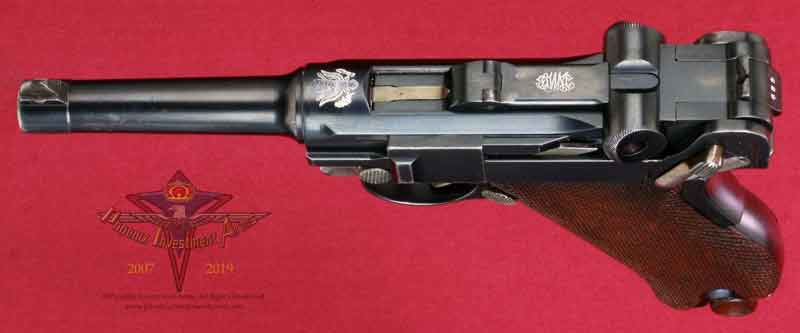 |
|
This DWM American Eagle Fat Barrell is in good - very good condition and offered for $7,285.00 over-the-counter. This Parabellum show minor honest wear and a strong shiny barrel. This gun may be sold before being posted as such on the internet. Any questions to Josef@phoenixinvestmentarms.com. We reserve the right to sell any internet offering to a direct sale and no not warrant the availability of any firearm that does not have a physical deposit. This gun may be withdrawn without notice for in-store sale. Call for availability. |

|
Home | New Additions | 1900-06 | WWI Imperial | Carbines | Artillery | Imperial Navy | Police Models | Archived Lugers | Accessories
Sell Your Gun | Notices | Good Info (C&R) | Ordering | Contact Us | Gun Shows | Legal Stuff | Testimonials | Notices | Holsters | Books
Top of Page
LAYAWAYS: Sometimes our "significant other" doesn't understand the beauty, craftsmanship and investment potential of one of these investor grade weapons. In these circumstances where discretion becomes the better part of valor we will accept layaways of up to one year with at least 20% down and some activity occurring monthly to insure that after one year the sale is completed. Cancellations of layaways forfeit 33% if done within two months, otherwise 100%. You can transfer a layaway to a consignment sale atany time. See "Legal" for exact terms. |
|
3 Day Return Policy We honor a three day return policy. We will answer any questions, send you any pictures, as detailed as you want, to insure that what we are showing you is what you want to see, before you buy it. See Legal. |
||
|
